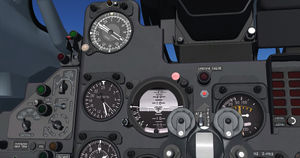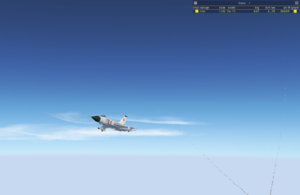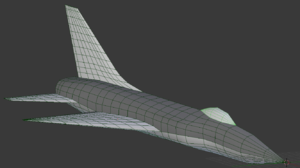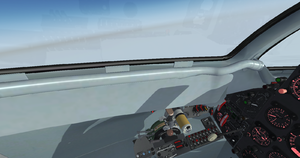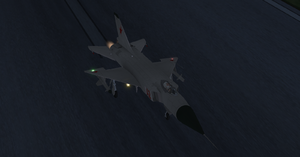Sukhoi Su-15
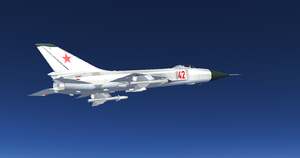 | ||
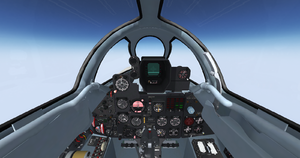 | ||
| Type | Fighter aircraft, Interceptor aircraft, Military aircraft, Supersonic aircraft, Jet fighter | |
|---|---|---|
| Configuration | Delta-wing aircraft | |
| Propulsion | Twinjet (Jet aircraft, Twin-engine aircraft) | |
| Manufacturer | Sukhoi | |
| Author(s) | Victor Slavutinsky | |
| FDM | JSBSim | |
| --aircraft= | Su-15 | |
| Status | Unknown | |
| Download |
| |
| Forum |
| |
| License | GetToFlyOnly | |
| ||
|
| ||
Su-15 - semi-automated Mach 2, 20 km interceptor with missiles armament.
About
The Sukhoi Su-15 (NATO reporting name "Flagon") was the second semi-automated interceptor on the planet, the first being its predecessor, the Sukhoi Su-9, and for its time this was quite advanced. It worked in tandem with ground radar, receiving calculated direction data via a encoded radio link, but also had its own radar with a working distance of 30 km (16 nm), which was huge at time. It was first aircraft ever able to catch a target at both head-on and following courses, at a speed of Mach 2 at an altitude of approximately 20 km (66,000 ft.), and target speeds of Mach 3 at approximately 25 km (82,000 ft.). In fact, with all that equipment, it was first ever aircraft in which the pilot was more of an operator than pilot — the plane could intercept a target by itself in both ground-guided and radar-guided modes.
But its effectiveness was bought at a high price. Being a heavy plane with small wings, it has an extremely high landing speed of 350 km/h, similar to the Space Shuttle and Buran, both of which are spaceplanes(!). It was also unstable at those kind of speeds, while oversonic yaw maneuvering was limited by its side intakes, a first for Soviet aircraft. Fuel consumption was similar to a rocket, and enormously high by modern standards — it got through 8 tonnes of kerosene in a normal 15-minute, Mach 2 interception flight.
Regular pilot training - happily Su-15 was not used at real targets often - cost the same amount of money as making cosmonaut out of him and sending him at space; common 200 flight hours per year turned into monstrous 1000tonnes of fuel, while weight of whole R-7 rocket was 280tonnes only. At modern prices such training would cost 1million of, heh, money per year - really, not less, so expenses of usage was comparable with cost of plane itself for sure.
Interception of 2Mach target, including radar selection, friend-or-foe semiautomatic recognition, missile guidance head lock, so on, could occur at head-on course only, since other way Su could not reach it; so relative approaching speed was up to 4Mach, and all process had to be pressed in 30seconds, without second chance. 3Mach demanded even faster reaction - but it should be made without any mistake, since a target would be the bomber with thermonuclear bombs. In addition, return at 1 tonne of leftover fuel was a normal part of interception flights.
Summing all that, needed piloting class was high - so high that at most units of anti-aircraft warfare, which was armed with Su-15, cadet who flew it first time alone received a cake from colleagues; it was not tradition common with other units. Other prove - only pilots of Tu-128, flying even more heavy interceptors for hours, had greater incomes in whole air forces.
Even with such qualified pilots, area of plane usage was quite narrow. Not maneuverable, without place for regular gyro sight at cockpit, it has standard armament of two heavy missiles only - typical second generation interceptor, with sole target as heavy high altitude bomber; first series was completely useless against low-speed low-altitude targets. Some of limitations was overpassed at later modifications, but fact that Su-15 as whole was used for quarter of century, and, with modifications, was produced 1300 times, is mostly prove that there is nothing more constant than temporary than evidence of its versatility.
Fact is representative more that, instead of other former Soviet fighters as MiG-21, not one flew in private hands after retiring. It's just too hard, too demanding, to be common fun. Once it was case three Su crashed in a row, in just 15minutes, due to foggy conditions and guiding system absence at receiving port. All three pilots was high-rank - so to use it alone, without ground automatics, would be risky even at future times with its artificially advanced humans. Heh. At fact, pilots respected plane, some of them even liked it, but, seems to be, not one really loved it, way this was with some other types. Well, it's hard to love something that do at its own better than under Your control.
I made model of it mostly as part of personal investigation of Yury Gagarin life and death circumstances - as Alexey Leonov, friend of Gagarin and man who made first ever EVA, said that Su was involved in second. So exactness of model is as high as possible; with conditions in which documentation of it is not at public domain yet.
Also, it was test of ability to make mostly JSBSim realistic model, which could run standalone with all systems, each switch, by minimal fixes and changes; of course it was some additional social test of community, etc.
Features
- Detailed 3D external model and virtual cockpit based on real photos
- Exact textures with special Soviet fonts
- Sounds from real sources
- Common FDM generated by Datcom with fuselage form modeling
- Advanced FDM polished by Boeing Panair panel code program.
- Further polishing of FDM with XFLR5
- Each surface, gears, tanks, missiles inclusive, have its own forces and moments calculated
- Blowing flaps with realistic effect on pitch
- Braking chute
- Engines based on graphs from real MiG-21 documentation, since it has same one, with possibility of overheating and fire
- Extinguishing system, and ability to land at one engine
- Intakes calculated realtime, with engines cutoff at resurfacing or aerodynamic shadowing mistakes
- Electrical, hydraulic, pneumatic, other systems with flows calculation via JSBSim, which means tens of milliseconds exactness, and wide specter of possible malfunctions on usage mistakes. More than 1Mb of xml code.
- Disturbed instrumentation with lags, which also calculated via JSBsim, and depended on Pitot tubes
- Pitot tubes with possibility of freezing and heaters which could burn out
- Oxygen system used by pilot and engines airstart, with possibility of pilot knockout on exhaust
- Breakable gears, blowing flaps, canopy
- Chain reactions of malfunctions caused by some minor mistakes of pilot
- Manually tuned radicompass working with NDB beacons
- "Asure" radioline commands directions to MP targets or runways
- Autopilot working from stop to stop, including takeoff, passing to beacon, MP target following, interception, landing
- Stabilization and antiskid automation
- Braking chute
- Droppable external tanks with moments and drags
- Radar working at MP targets, based on real Su-15 work movie and real data; as real one, can not see targets below model or behind mountain
- Infrared R-8P and halfactive radar R-8R missiles working at MP targets, based on real data
- Guidance heads of missiles calculated realtime, means it can lose target that making an antimissile maneuvers
- FDM of missiles calculated via JSBSim, means these could lose stability on turns. Instead of other FG missiles, these are calculated as standard JSBSim models, by data sets made by Datcom, plus own stability automation is calculated. Basically, exactness is just same as of plane model itself. Comparison with Yasim/JSBSim models quality matching is relevant here. 100Kb of xml code per missile.
- Basic version with missiles and some systems calculated by Nasal. A bit rough, still missiles works with real calculation of forces and alpha/beta, so maneuvering one slows realistically faster than one flying straight, and would not catch maneuverable target, while heavy bomber should not be an question - it's most realistic missiles at FG still. For old PCs, 7..10fps at Athlon 64X2 4000+, GeForce GTS 450, 2Gb Ram.
- Custom MPClash protocol, allowing missiles dogfight training trough MP, including missile launched by other player visibility, radar irradiation warner, lamps for own missiles catches and for catches of other pilot. At now "Su-15" model is sole one at FG having such abilities. Others can shoot in the air only, since they do not see missiles of each other, and not affected by it in any way, excluding MP messages spam; while protocol could be expanded easily with other missiles types, already existed ones inclusive. To change catch lamp to some breakage calculator is matter of day; so at now "Su-15" model is single one at FG which can shoot down model of other player really. A bit aggressive, still not one else deals with others in any way.
- Exact Russian/English PDF documentation with screenshots for any important action
- Some ALS candies - external and internal shadows, canopy glass reflection, red instrumentation light, reheat exhaust, etc.
- GetToFlyOnly license above all that, means You can fly model personally for free, but got to ask me for any other usage. Since some miscomprehendings with FG community, started with "MiG-15" model at 2010, went quite far with "Vostok-1" model at 2011, and not solved with that one and MPClash GPL proposition yet. Lone work for free is possible, it's called "hobby". Common work without own authority is possible, it's often called just "work". Both simultaneously, plus without respect - not. And missiles of "Su" is aimed at people thinking other way. Let's see if these will work.
Tutorial videos
Startup:
Automatic takeoff:
Manual takeoff:
Autopilot beacon following:
Autopilot port following:
Automatic convoy:
Automatic and manual interception:
Airstart at altitude cutoff:
Automatic landing:
Manual landing:
Model performance
- Maximum speed: Mach 2.05
- Maximum speed without reheat: Mach 1.5
- Practical ceiling: 18 km
- Dynamic hop ceiling: 23 km
- Maximum flight duration: 3 hours
- Maximum flight duration with reheat: 30 min
- Takeoff speed: 400 km/h
- Landing speed with blowing flaps: 325 km/h
- Stall speed: 300 km/h
- Minimal runway length: 1,500 m
- Radar range: 40 km
- Radar selection range: 30 km
- Medium missiles working range: 10 km
Model author
Victor Slavutinsky, vitosnet <at> mail <dot> ru.
External links
| ||||||||
